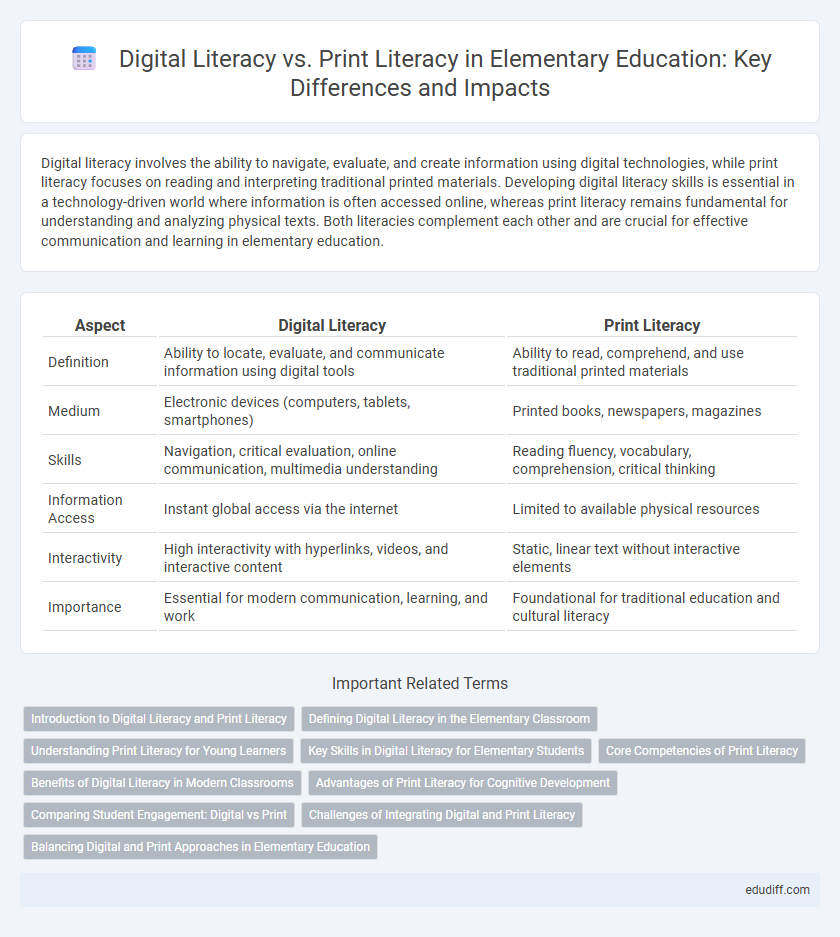Digital literacy involves the ability to navigate, evaluate, and create information using digital technologies, while print literacy focuses on reading and interpreting traditional printed materials. Developing digital literacy skills is essential in a technology-driven world where information is often accessed online, whereas print literacy remains fundamental for understanding and analyzing physical texts. Both literacies complement each other and are crucial for effective communication and learning in elementary education.
Table of Comparison
| Aspect | Digital Literacy | Print Literacy |
|---|---|---|
| Definition | Ability to locate, evaluate, and communicate information using digital tools | Ability to read, comprehend, and use traditional printed materials |
| Medium | Electronic devices (computers, tablets, smartphones) | Printed books, newspapers, magazines |
| Skills | Navigation, critical evaluation, online communication, multimedia understanding | Reading fluency, vocabulary, comprehension, critical thinking |
| Information Access | Instant global access via the internet | Limited to available physical resources |
| Interactivity | High interactivity with hyperlinks, videos, and interactive content | Static, linear text without interactive elements |
| Importance | Essential for modern communication, learning, and work | Foundational for traditional education and cultural literacy |
Introduction to Digital Literacy and Print Literacy
Digital literacy involves the ability to effectively use digital tools, understand online information, and communicate through electronic platforms, essential for navigating today's technology-driven world. Print literacy focuses on reading and comprehending traditional printed materials such as books, newspapers, and magazines, forming the foundation of academic learning and information retention. Both digital and print literacy skills are crucial for elementary students to develop comprehensive reading and communication proficiencies.
Defining Digital Literacy in the Elementary Classroom
Digital literacy in the elementary classroom encompasses the ability to effectively use digital tools, interpret multimedia content, and safely navigate online environments. Unlike print literacy, which focuses on reading and writing traditional texts, digital literacy integrates skills such as evaluating digital sources, understanding online privacy, and creating multimedia presentations. Developing these competencies early supports students' critical thinking and prepares them for a technology-driven world.
Understanding Print Literacy for Young Learners
Print literacy for young learners involves recognizing letters, understanding words, and comprehending printed texts, essential for foundational reading skills. Developing phonemic awareness and decoding abilities enables children to interpret written language effectively. Mastery of print literacy supports academic success and prepares students for more complex literacy challenges.
Key Skills in Digital Literacy for Elementary Students
Digital literacy for elementary students includes critical skills such as navigating online resources safely, understanding digital content, and basic troubleshooting of devices. Fundamental abilities involve recognizing credible sources, practicing online safety and privacy, and using multimedia tools for learning and communication. Developing these digital skills alongside print literacy enhances students' overall comprehension and adaptability in diverse learning environments.
Core Competencies of Print Literacy
Print literacy centers on understanding and using written language, emphasizing decoding skills, vocabulary development, and comprehension strategies. Core competencies include recognizing letters and words, phonemic awareness, and the ability to interpret text structures such as narratives and informational content. Mastery of print literacy forms the foundational skills necessary for effective reading and writing in traditional educational settings.
Benefits of Digital Literacy in Modern Classrooms
Digital literacy equips elementary students with essential skills like navigating online resources, evaluating information credibility, and using digital tools for collaboration. These abilities foster interactive learning, critical thinking, and adaptability in modern classroom environments. Enhanced digital literacy prepares students for future academic success and a technology-driven world.
Advantages of Print Literacy for Cognitive Development
Print literacy enhances cognitive development by fostering deeper comprehension and critical thinking skills through tactile engagement with physical books. Reading printed text improves memory retention and focus by reducing digital distractions, enabling sustained attention for better learning outcomes. Exposure to print materials also supports vocabulary expansion and language acquisition through direct interaction with consistent formatting and spatial cues.
Comparing Student Engagement: Digital vs Print
Student engagement tends to vary between digital and print literacy formats, with digital resources often providing interactive elements such as videos, quizzes, and hyperlinks that capture students' attention more effectively. However, print literacy fosters deeper focus and comprehension by minimizing distractions and allowing for tactile interaction with the text. Research shows that combining both digital and print materials can enhance overall student engagement and improve learning outcomes.
Challenges of Integrating Digital and Print Literacy
Integrating digital and print literacy in elementary education faces challenges such as ensuring equitable access to technology and balancing screen time with traditional reading. Teachers must develop strategies to address varying student proficiency levels in both formats while maintaining engagement. Limited resources and training hinder effective implementation of combined literacy instruction.
Balancing Digital and Print Approaches in Elementary Education
Balancing digital and print literacy in elementary education enhances students' learning experiences by integrating interactive technology with traditional reading skills. Research shows that combining e-books, educational apps, and hands-on print materials supports diverse learning styles and improves comprehension and critical thinking. Implementing a hybrid approach fosters digital fluency while preserving foundational print literacy essential for academic success.
Digital Literacy vs Print Literacy Infographic

 edudiff.com
edudiff.com